You only need 7 ingredients to make these yeasted honey butter rolls. Fluffy, flaky, soft, and buttery, with a dose of honeyed sweetness, these fresh rolls are in another league than anything store-bought. If you’re a bread beginner, reference my Baking with Yeast Guide for answers to common yeast FAQs.
This recipe is brought to you in partnership with Red Star Yeast.
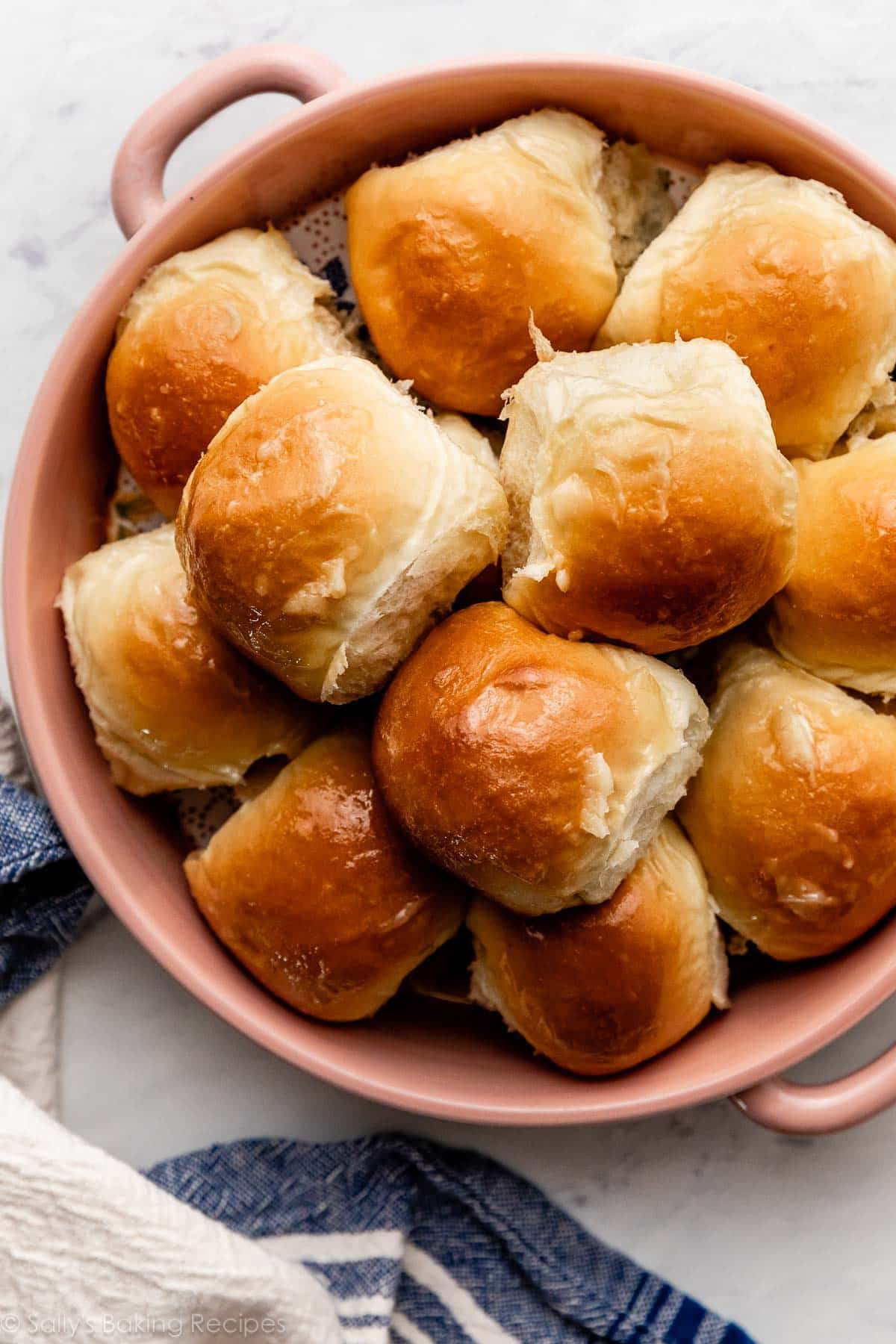
These soft, flaky, golden honey butter rolls might just be my very favorite rolls to make. I mean, I love my classic dinner rolls, but with the addition of honey, both in the rolls and on top? These rolls are the bee’s knees!
One reader, Mia, commented: “What an amazing recipe! I haven’t even made bread much before. Yet this turned out so successfully. Will definitely be making it on the regular…★★★★★“
I first published this recipe in 2015, and have recently made a couple small changes to it. The recipe used to include granulated sugar, for proofing the yeast, but you can actually just use a teaspoon of honey for this! (Convenient, since you’re already using honey in the dough.) I’ve also extended the kneading time to 8–10 minutes, so they’re extra soft. If you’ve made these garlicky homemade breadsticks before, the kneading instructions are exactly the same.
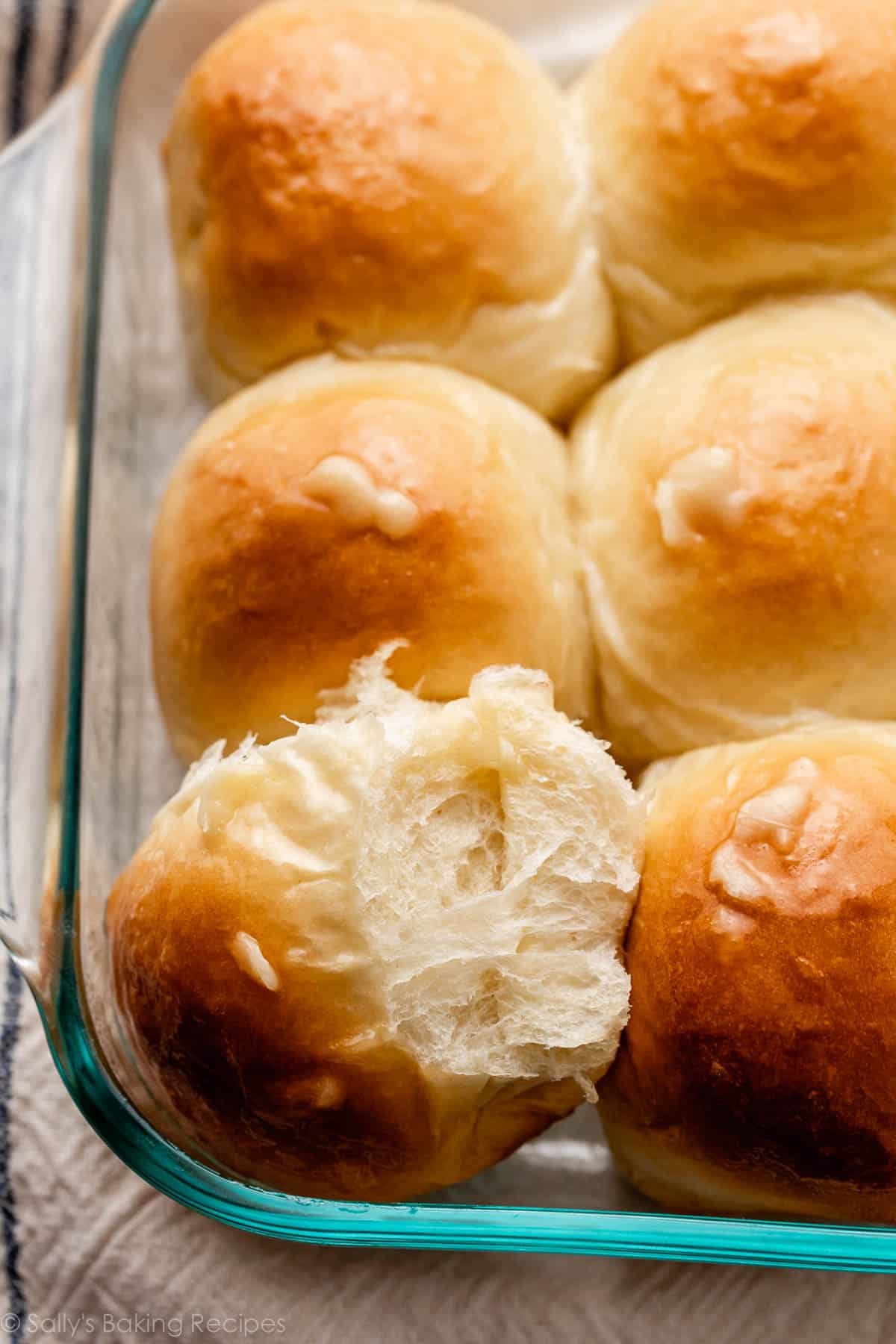
This is an old-fashioned, made-with-love dinner roll recipe, with honey butter going in and on the rolls.
Ingredients You Need for This Rich Dough
Unfortunately, this dough doesn’t come with a winning lottery ticket (though we could call the honey liquid gold!). Rather, “rich” correlates with the amount of fat in the dough. Here’s the difference:
- Rich dough: The softer the bread, the more fat in the dough. For example, this dough includes whole milk, butter, and egg. Recipes like my easy cinnamon rolls, raspberry sweet rolls, pizza pull-apart rolls, and brown butter sage dinner rolls all start with a rich dough.
- Lean dough: The crustier and chewier the bread, the less fat in the dough. Recipes like chewy homemade bagels and soft pretzels, pizza dough, focaccia, and artisan bread all use a lean dough.
You need 7 ingredients total:
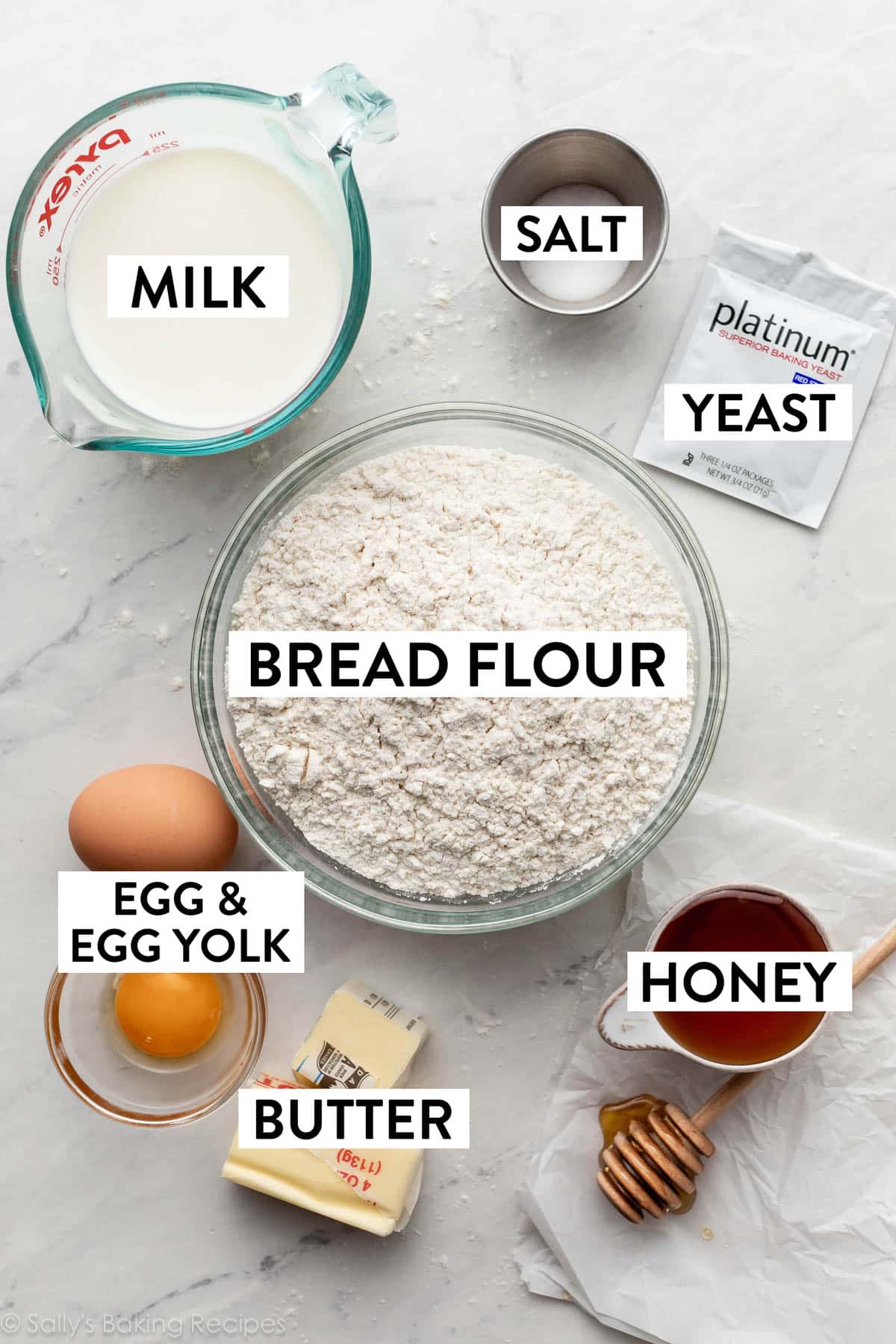
- Milk: Liquid activates the yeast. For the best rolls, use whole milk. Nondairy or low-fat milks work too, but whole milk produces phenomenal flavor and texture.
- Yeast: You can use active dry yeast or instant yeast. If using active dry yeast, the rise times will be a little longer. I recommend Platinum Yeast from Red Star, which is an instant yeast blended with natural dough improvers.
- Honey: The honey feeds the yeast, increases its activity, and tenderizes the dough. Plus it provides that distinctive sweetness these rolls are made for!
- Egg: 1 egg provides structure and flavor, and that extra egg yolk adds richness and makes the rolls supremely soft. Don’t skip it.
- Butter: Butter in the dough promises a flavorful, soft honey butter roll. And is there anything better than slathering honey butter on top of the warm rolls?
- Salt: You can’t make flavorful bread without salt!
- Flour: You can use all-purpose flour or bread flour in this recipe. All-purpose flour is convenient for most, but bread flour produces chewier rolls. There are no other changes to the recipe if you use bread flour. I use bread flour in my honey butter rolls because it contains more gluten than all-purpose. Extra gluten helps make finished rolls extra chewy and, um, more bread-like. Technical terms here.
Making rolls from scratch may sound intimidating and time-consuming, but most of that time is hands-off. If you’re new to baking bread, reference my Baking with Yeast Guide.
One reader, Erin, commented: “This is my go-to recipe for dinner rolls. They are delicious! I make them all the time for family gatherings and they are always a hit. Before I came across Sally’s blog, I never had the confidence to try and make bread of any kind. Because of her detailed instructions and photos, I am now fully confident in my ability to make not only rolls, but tons of other recipes as well. ★★★★★“
The 1st step is to proof your yeast, a step I take even if I’m using instant yeast. All you do is mix the yeast with the warm liquid (milk), and a little sugar (honey). Cover and let it sit for 5–10 minutes until foamy and frothy on top. This proves your yeast is active and ready to get to work:
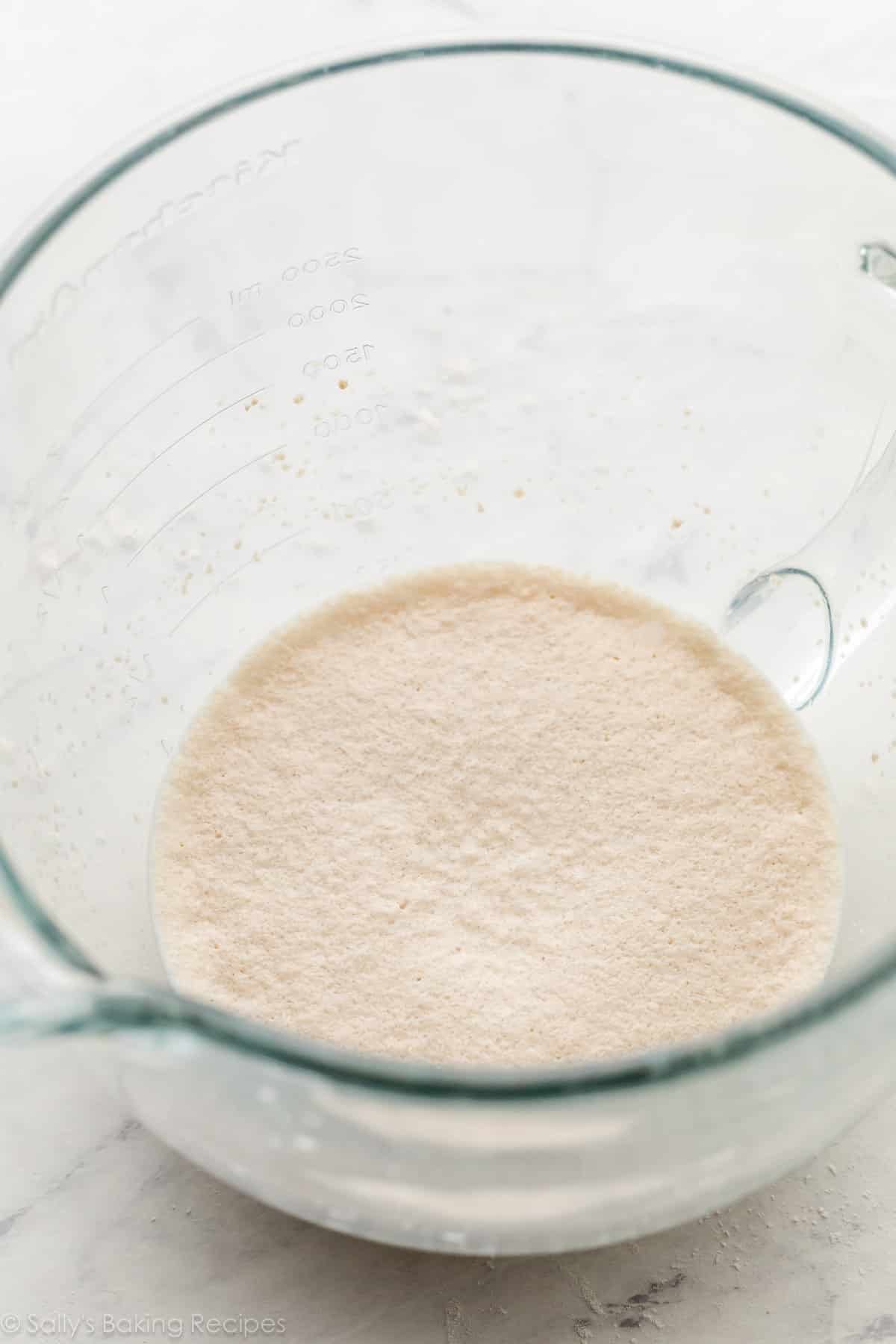
Now you’ll add the rest of the dough ingredients. The process is really easy, and kneading is an important step.
Honey Butter Rolls: Kneading the Dough Is Key
Kneading dough is a common step in bread baking, and this particular dough definitely benefits from a long kneading step (about 8–10 minutes) to help ensure the honey butter rolls stay soft. You can knead dough with your hands or in a stand mixer. A stand mixer obviously makes the job hands-off, but if you don’t have one, kneading is a great stress reliever. 😉
The dough should feel slightly tacky, but not overly sticky. On a lightly floured work surface, using the heels of your hands, stretch and fold the dough with gentle motion. If you’d like a visual of how to knead the dough by hand, you can watch the full video tutorial in my post on how to knead dough.
Kneading the dough serves a couple purposes. First, it incorporates air into the dough, which helps keep the rolls nice and soft. It also encourages the proteins in the flour and moisture in the dough to link together, forming a strong gluten network, which is essential for retaining the gas produced by the yeast. Gluten is what makes bread deliciously chewy.
You know your kneaded dough is ready to rise when it stretches without immediately tearing. After kneading, the dough will be soft and supple, and a windowpane test is always helpful. You can poke the dough with your finger, too. If it slowly bounces back, it’s ready to rise.
After kneading, tear off a small (roughly golfball-size) piece of dough and gently stretch it out until it’s thin enough for light to pass through it. Hold it up to a window or light. Does light pass through the stretched dough without the dough tearing first? If so, your dough has been kneaded long enough and is ready to rise. If not, keep kneading.
Pictured on the left below is the dough after kneading. It’s smooth and stretchy, and ready to rise. Place the dough in a large greased bowl, turn the dough to coat it in the oil, and then cover it and set it aside. It will double in size in about 1–2 hours, pictured on the right.

Shaping the Rolls
Punch down the risen dough to release the air, and then divide the dough into 15 pieces, roughly equal in size (about 2 ounces/60g each, but they don’t have to be exact!). Take a piece and stretch the top of the dough while pinching and sealing the bottom. Make sure the rolls are smooth on top and sealed on the bottom. I shape hot cross buns the same exact way.
Arrange them in a greased baking pan, loosely cover, and let the shaped rolls rise for another hour before baking.
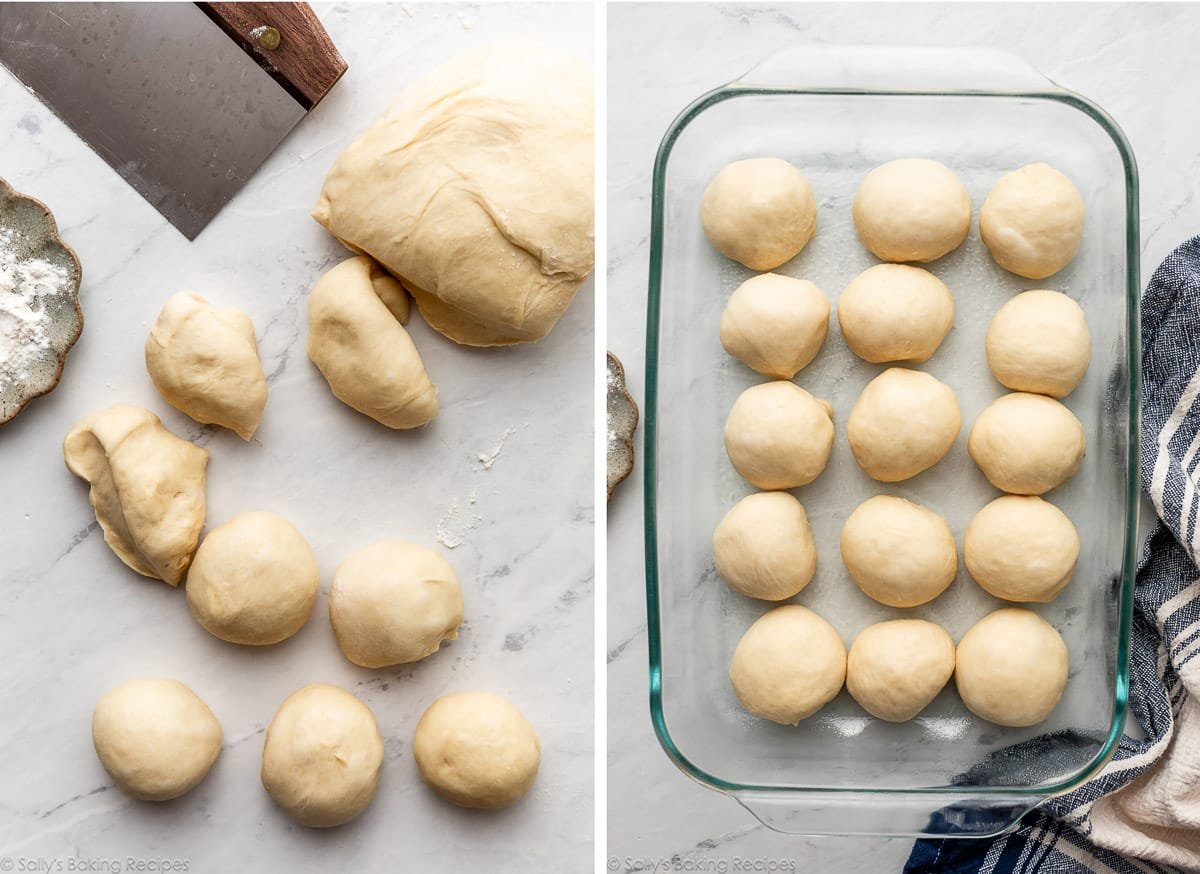
I didn’t snap a picture of the rolls after rising, but they puff up quite a bit. Then, bake until golden brown.
Honey Butter Topping
Spreading on a sweet and creamy honey butter is the perfect finishing touch to the warm honey butter rolls. You need 2 ingredients for the honey butter topping. Can you guess what they are? LOL.
Make sure your butter is super soft, so you can easily mix it with the honey. I just use a fork to do this, but you could use an electric mixer if you’d prefer. As soon as they’re out of the oven, spread the honey butter on top of the warm rolls. (Just use a knife, or an icing spatula also works great for this.)
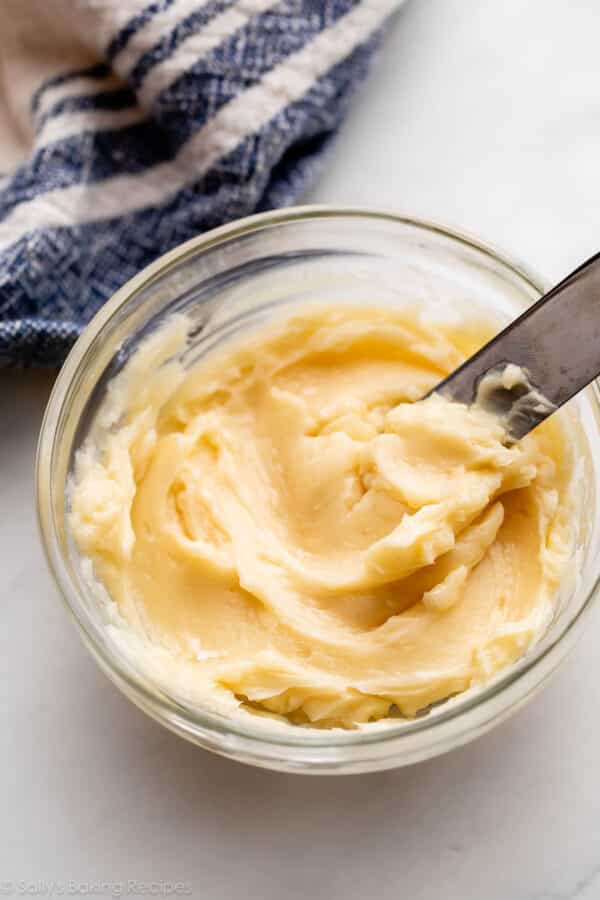
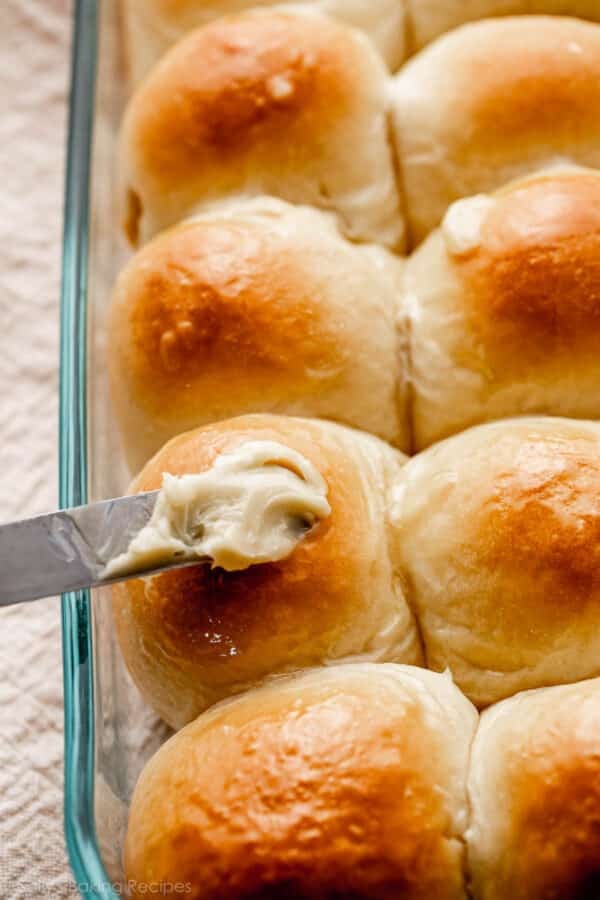
You’ll have extra honey butter to serve alongside the rolls.
How Are These Different?
My popular soft dinner rolls are flaky, soft, and buttery. And so are today’s honeyed version. But today’s recipe produces slightly sweeter and richer-tasting rolls, sort of like those “Hawaiian rolls” you can purchase at the store. They’re a real treat!
Whole wheat version: Try my honey whole wheat dinner rolls.
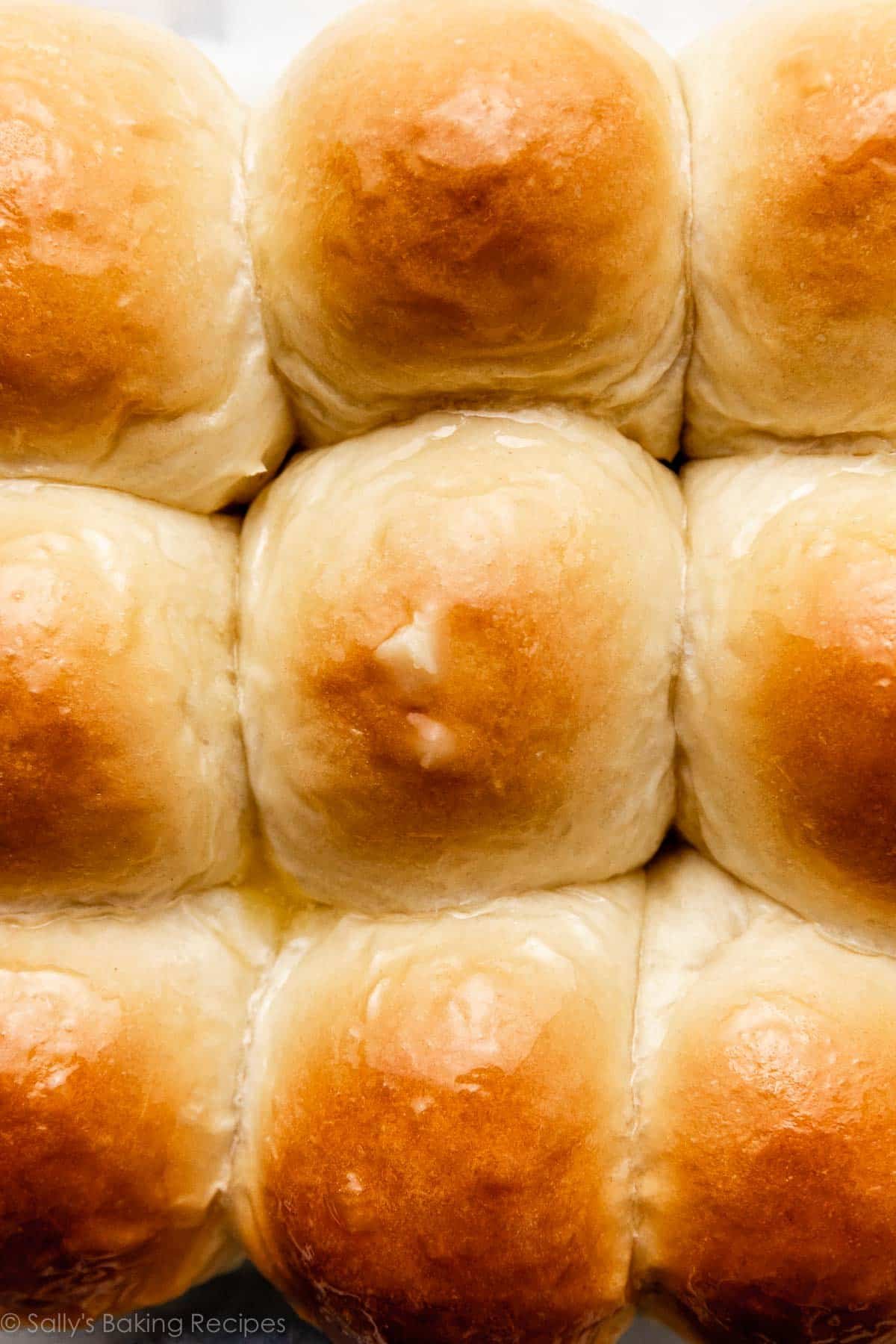
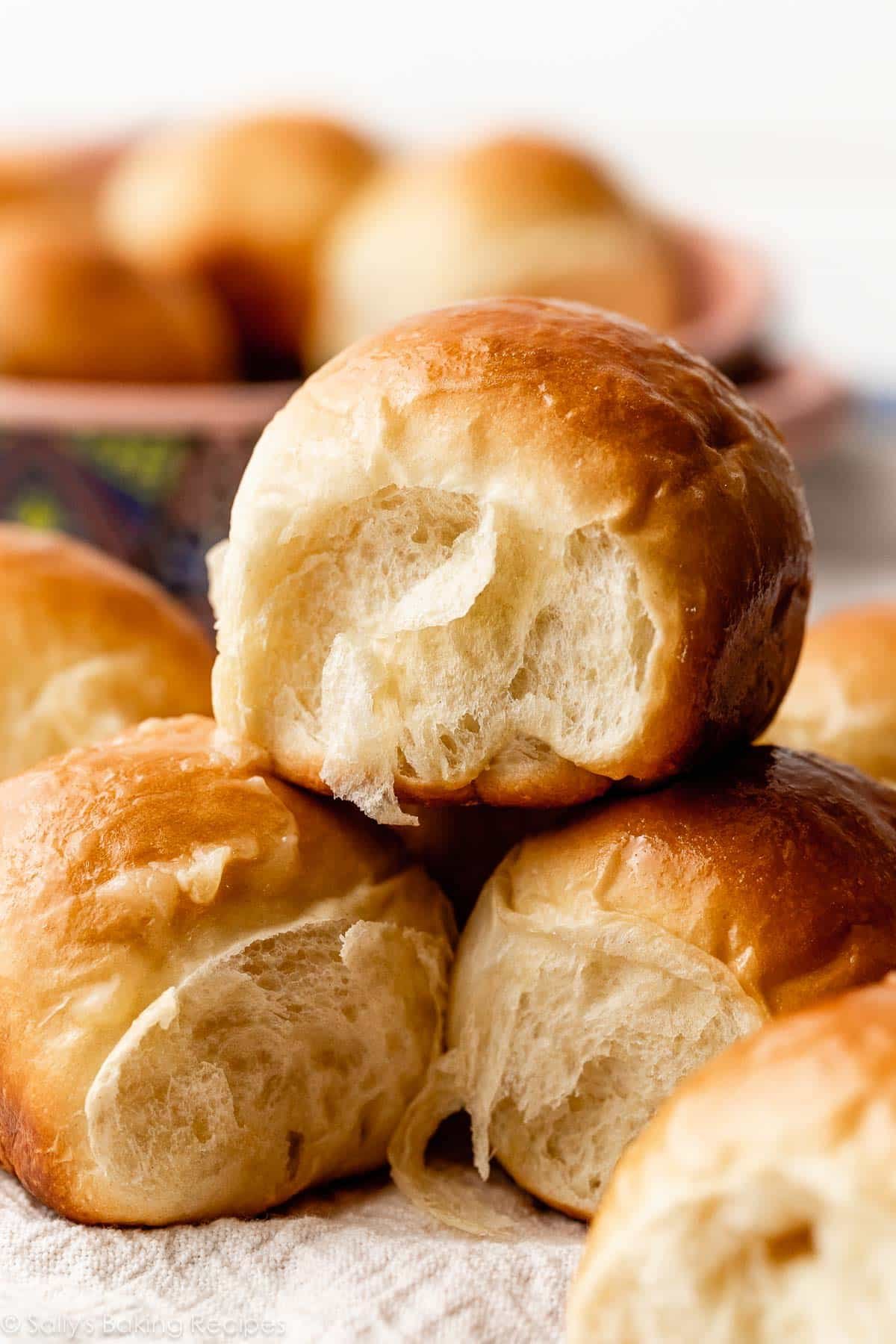
The make-ahead/overnight option detailed in the Notes below is especially helpful if you want fresh-baked honey butter rolls for a big holiday meal, such as Easter brunch or Thanksgiving dinner. Or, you know, Tuesday. 😉
Print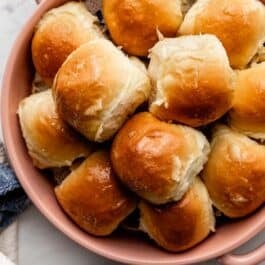
Honey Butter Rolls
- Prep Time: 3 hours, 25 minutes
- Cook Time: 22 minutes
- Total Time: 3 hours, 45 minutes
- Yield: 15 rolls
- Category: Bread
- Method: Baking
- Cuisine: American
Description
You need just 7 ingredients to make these extra soft and flaky honey butter rolls. See recipe Notes for freezing and overnight instructions. You can also reference my Baking with Yeast Guide for answers to common yeast FAQs.
Ingredients
- 1 cup (240ml) whole milk, warmed to about 110°F (43°C)
- 2 and 1/4 teaspoons (7g) Platinum Yeast from Red Star instant yeast or active dry yeast (1 standard packet)
- 1/4 cup (85g) + 1 teaspoon honey, divided
- 1 large egg + 1 egg yolk
- 1/4 cup (4 Tbsp; 56g) unsalted butter, melted and slightly cooled
- 1 teaspoon salt
- 3 and 1/2 cups (455g) bread flour (spooned & leveled)
Topping
- 1/4 cup (4 Tbsp; 56g) unsalted butter, very soft
- 2 Tablespoons (42g) honey
Instructions
- Prepare the dough: Whisk the warm milk, yeast, and 1 teaspoon honey together in the bowl of your stand mixer. Loosely cover and allow to sit for 5–10 minutes until foamy and frothy on top. *If you do not own a stand mixer, you can do this in a large mixing bowl and in the next step, mix the dough together with a large wooden spoon/silicone spatula. It will take a bit of arm muscle. A hand mixer works, but the sticky dough repeatedly gets stuck in the beaters. Mixing by hand with a wooden spoon or silicone spatula is a better choice.*
- With the stand mixer running on low speed with the dough hook attachment, add the remaining honey, egg, egg yolk, melted butter, salt, and 3 cups of flour. Mix on low speed for 1 minute, then add remaining 1/2 cup of flour. Mix on low speed for 1 minute as it all combines. The dough should be thick, yet soft, and just slightly sticky. It should pull away from the sides of the bowl as it mixes. When it does, it is ready to knead. If, however, the dough is too sticky to handle, mix in more flour, 1 Tablespoon at a time. Make sure you do not add too much extra flour; you want a soft, slightly sticky dough.
- Knead the dough: Keep the dough in the mixer and beat for an additional 8-10 full minutes, or knead by hand on a lightly floured surface for 8-10 full minutes. (If you’re new to bread-baking, my How to Knead Dough video tutorial can help here.) If the dough becomes too sticky during the kneading process, sprinkle 1 teaspoon of flour at a time on the dough or on the work surface/in the bowl to make a soft, slightly tacky dough. Do not add more flour than you need because you do not want a dry dough. After kneading, the dough should still feel a little soft. Poke it with your finger—if it slowly bounces back, your dough is ready to rise. You can also do a “windowpane test” to see if your dough has been kneaded long enough: tear off a small (roughly golfball-size) piece of dough and gently stretch it out until it’s thin enough for light to pass through it. Hold it up to a window or light. Does light pass through the stretched dough without the dough tearing first? If so, your dough has been kneaded long enough and is ready to rise. If not, keep kneading until it passes the windowpane test.
- 1st rise: Lightly grease a large bowl with oil or nonstick spray. Place the dough in the bowl, turning it to coat all sides in the oil. Cover the bowl with aluminum foil, plastic wrap, or a clean kitchen towel. Allow the dough to rise in a relatively warm environment for 1–2 hours or until double in size. (For a tiny reduction in rise time, see my answer to Where Should Dough Rise? in my Baking With Yeast Guide.)
- Grease a 9×13-inch baking pan or two 9-inch square or round baking pans. You can also bake the rolls in a cast iron skillet or on a lined baking sheet.*
- Shape the rolls: When the dough is ready, punch it down to release the air. Divide the dough into 15 pieces, roughly 2 ounces or 60g each. (Just eyeball it—doesn’t have to be perfect!) A bench scraper is always helpful for cutting dough. Shape each piece into a smooth ball. Arrange in prepared baking pan.
- 2nd rise: Loosely cover with plastic wrap and allow to rise until doubled in size and puffy, about 1 hour.
- Preheat oven to 350°F (177°C). Bake the rolls for 20–25 minutes or until golden brown on top, rotating the pan halfway through. If you notice the tops browning too quickly, loosely tent the pan with aluminum foil.
- Make the honey butter topping: While the rolls bake, mix the topping ingredients together to make a creamy honey butter. Remove the rolls from the oven when they are done and spread a generous amount of honey butter onto each warm roll. Serve with any remaining honey butter.
- Cover leftovers and keep in the refrigerator for up to 1 week or freeze for up to 3 months, then thaw overnight in the refrigerator. Warm up in a 300°F (149°C) oven for 10 minutes.
Notes
- Freezing Dough Instructions: Prepare recipe through step 6. Place shaped rolls in a greased baking pan, cover tightly, and freeze for up to 3 months. Once frozen, the dough balls won’t stick together anymore and you can place them in a freezer bag if needed. On the day you serve them, arrange the dough balls in a greased baking pan, cover tightly, then let them thaw and rise for about 4–5 hours. Bake as directed. You can also freeze the baked dinner rolls. Allow them to cool completely, then freeze for up to 3 months. Thaw in the refrigerator or at room temperature, then reheat as desired. If reheating the whole pan, lightly cover and reheat in a 300°F (149°C) oven for about 10 minutes or until warm.
- Overnight Dough Instructions: Prepare the recipe through step 6. Cover the shaped rolls tightly and refrigerate for up to about 15 hours. At least 3 hours before you need them the next day, remove the rolls from the refrigerator, keep covered, and allow to rise on the counter for about 1–2 hours before baking. Alternatively, you can let the dough have its 1st rise in the refrigerator overnight. Cover the dough tightly and place in the refrigerator for up to about 15 hours. Remove from the refrigerator and allow the dough to fully rise for 2 more hours. Continue with step 5.
- Special Tools (affiliate links): Stand Mixer (or Glass Mixing Bowl with Silicone Spatula / Wooden Spoon) | 9×13-inch Glass Baking Pan, 2 9-inch Round Baking Pans, 2 9-inch Square Baking Pans, Cast Iron Skillet, or Baking Sheet | Bench Scraper
- Baking Pan: I prefer baking the rolls in a glass 9×13-inch baking pan because I find they brown a little too quickly in a metal pan. But as long as you bake the rolls on a lower oven rack and keep your eye on them, any pan is great. You can also bake these rolls in a large cast iron skillet, in two 9-inch round or square baking pans, or on a lined baking sheet. Bake time remains the same.
- Milk: Whole milk or even buttermilk are ideal for the best, richest flavor and texture. Keeping that in mind, feel free to substitute with a lower-fat or nondairy milk.
- Yeast: Platinum Yeast from Red Star is an instant yeast. You can use Red Star Yeast active dry yeast instead. Rise times will be slightly longer using active dry yeast. Reference my Baking with Yeast Guide for answers to common yeast FAQs.
- Flour: For extra chewy rolls, I like to use bread flour. You can use all-purpose flour or bread flour. All-purpose flour is convenient for most, but bread flour produces a chewier texture. The rolls are still soft and fluffy no matter which you use. Either flour is fine and there are no other changes to the recipe if you use one or the other.
- Can I Use Whole Wheat Flour? I don’t recommend it for this recipe, but you can replace up to 1 cup (about 120–130g) of flour with whole wheat flour. Expect a denser roll. Or try my honey whole wheat dinner rolls recipe instead.



















Hello,
These look absolutely delicious! Can I substitute the honey in the butter with Italian garlic seasoning? If so, how much should I put? Thanks!
Hi Owen! We haven’t tested this recipe with Italian garlic seasoning, but don’t see why it wouldn’t work! You may also love these homemade garlic knots (you could use the topping proportions from that recipe if desired). Let us know what you try!
I literally have made this page my go to for recipe base ideas. I absolutely love the portions in the ingredients, absolutely flawless recipes. These rolls are the best ones I’ve made and I’ve made a few different recipes.
Hi Gin, We are so glad that you’re enjoying these!
This is my go-to recipe for dinner rolls. They are delicious! I make them all the time for family gatherings and they are always a hit. Before I came across Sally’s blog, I never had the confidence to try and make bread of any kind. Because of her detailed instructions and photos, I am now fully confident in my ability to make not only rolls, but tons of other recipes as well. Sally, thank you for sharing your wonderful recipes and for all the hard work that goes into your blog!
I love these rolls! They are fantastic, and I’ll definitely be making them again. Just wondered how well they freeze?
Hi Sarah, you can absolutely freeze these. See recipe notes for freezing dough, or, you can freeze baked rolls for up to three months. Hope this helps!
My go to rolls that my adult children request. I have braided knotted and clover leafed them. We raise bees so my husband is thrilled when i find receipes with honey. Thanks for all the receipes you post
Sally,
These rolls are amazing, my family couldn’t get enough of them! They will be a staple in our household. I truly enjoy your website, everything I’ve made from your sight has been fantastic. Thank you for all your details they have made me become a better baker. I’m in my happy place when I’m baking !
For anybody wondering, I made some substitutes and they still turned out flaky and delicious!!
-unsweetened soy milk instead of whole milk
-AP flour instead of bread flour
-MAPLE SYRUP (I’m Canadian…) instead of honey
Delicious! Thanks sally!
If you freeze after baking should you wait & put honey butter on after defrosted & serve warm? Thanks!
Hi Anne, yes, that is what we would do. Enjoy!
Hi! Can you use all purpose flour?
Bread flour is best!
I want to make these for a Valentine’s Day dinner. I was thinking of either dusting them with flour over a heart-shaped stencil or attempting (yikes!) to score heart shapes in the top of each with my bread lame. Which do you think would be better? or do you have another idea? Thanks Sally!
Hi Trish, Those are both super cute ideas! Scoring the rolls may be the tastier option, but we’ve never tried it so I’m not sure how perfectly the heart shapes will turn out. You can also try making biscuits if you have a heart shape cookie cutter as they keep their shapes pretty well. Let us know what you try!
Do you think you could do this with a milk substitute, or water? I’m lactose intolerant so I generally use oat milk, but I don’t know if that would work.
Hi Elle, You can use a non-dairy milk here, but the texture of the rolls will slightly change. They won’t taste as fluffy and rich. Hope you enjoy them!
HI Sally, I have had great success with this recipe in the past. For my son’s bar mitzvah I wanted to make a homemade Challah. Have you ever made this as a braided loaf? Do you think that would work?
Hi Dana, We have never tried braiding this dough so I’m unsure of the final results. Please let us know if you try it!
These are amazing. My family loved them. We’re no longer buying dinner rolls. Four batches in 2 days….
Love, love love your recipes.
I don’t normally comment but these rolls are so delicate, fluffy and delicious. I didn’t have enough honey for the dough so I swapped in brown sugar. I did however have enough for the honey butter. Oh my!
I made sliders with Black Forest ham spicy honey mustard and I smear of the butter inside…
So good. Thanks sally what a great recipe!
Hi,
I am looking to make this recipe but I do not own a dough hook, any advice on mixing by hand? any recommendations for making it without a dough hook? is the consistency the same?
You can use the paddle (flat beater) attachment instead. Or you can mix the dough by hand with a rubber spatula or wooden spoon.
Hi there. I tried this recipe today and something went wrong on the second proof. My dough rolls didn’t rise at all and were almost the same size after an hour. I left them a bit longer and then decided to just try to bake them to see what would happen. After about 25 minutes in the oven, they were still only lightly brown and very doughy in the centre (and small). I will have to throw the batch of rolls out. I am new to bread making. Any idea what went wrong? I had a good amount of bubbles in the yeast at the start of the process before adding in the honey, eggs etc. and a good first rise.
Hi Sian! Thanks so much for trying these– it sounds like the shaped rolls simply weren’t done rising. The puffier and airier they are, the quicker they’ll bake. I would extend that 2nd rise time should you try the recipe again.
Made these today for Easter lunch and they were amazing. So easy to make and so so good. My kids couldn’t wait to start eating them!
I LOVED it!!!!!!it turned out greatttttt!!!thank yoooou dear sally!!!
Hi, I was wondering if you have a recipe for homemade hamburger buns? Thank you
Hi Elaina, I love using pretzel rolls for burgers! I’ve also used my dinner roll recipe and simply made fewer larger rolls for burgers and sandwiches.
I’m a professional chef and made 8x this recipe for Thanksgiving Community Dinner at church and they were a HUGE hit. If you want to double the recipe in the mixer (as someone previously asked) you can with no problem. I also shaped all the rolls into 15 ea at 60 gram into a 9 x 13 the day before the event and then topped with sprayed parchment then wrapped with film. Then the morning of the event I pulled all the pans out of the fridge and let them do final proof before baking. They were scrumptious.
This recipe is spot on and OH SO delicious! Thanks Sally!
Can I double this recipe or would I have to make two separate batches? I want to make them for Thanksgiving but I’ll need way more than 16!
Hi Taylor, for absolutely best taste and texture (and so you don’t waste your time!) I highly recommend making 2 separate batches.
If you haven’t made these, you absolutely need to. Plus, they freeze well. Also, they work great in a bread machine.
Very good recipe! I though my yeast was dead but obviously no ! The buns are a little dry the day after you make it because it dries during the “no-eating” time but it’s so DELICIOUS when it comes out from the oven ! With a pat of butter and touch of honey, it brings you in another world. I like to brush my rolls with egg yolks and serve like this. They are self sufficient.
Do you have a video tutorial? My first few batches were great, the next few too dry. Wondering if I’m kneading too hard
Hi Sandra! I have a video tutorial in this recipe for soft dinner rolls 🙂 I hope this helps!
Just made these and they turned out perfect!! I can’t wait to try different flavorings with these. Light and fluffy, perfect dinner rolls!!
Hello! Can you use flour instead of bread flour?
Thank you!
Hi Ally, you can use all-purpose flour instead, but the rolls won’t be as chewy and soft.
These rolls quickly became a family favorite. They are amazing and easy to make. I’m so happy I found this recipe.
I’ve been making these rolls for Thanksgiving every year since you posted them!! My family practically BEGS for them! They even joked they wouldn’t let me in without bringing them this year. Thank you for such a delicious recipe and even sweeter memories!❤️
So glad they’re a family tradition for you!!
These are so delicious! Best dinner rolls, hands down! Everything turned out great except that my rolls never really browned on top, even when they were finished cooking??? Any suggestions?
Hi Anna! I’m so happy you love these dinner rolls! How about turning on the broil element for the last 30 seconds to really brown those tops?